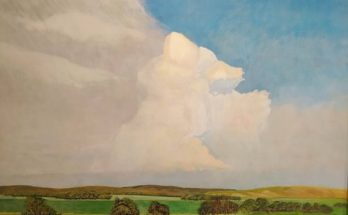By Natalie Taylor
On April 16, 2023 a panel of four visual artists shared their thoughts about art, focusing on “Poetics of Form.” Kathleen Cammarata, Tom Powers, Linda Laino, and Ri Anderson (in that order in the photo), whose works were exhibited at Casa de Europa, gave their personal insights.
Anderson is a photography-based artist who says her work is non-literal, she creates images, rather than taking photos of images. She has used innovation in technology by going more digital, and using Photoshop. Her images are put together in layers, up to 20, and she plays with opacity. An interesting work is “sweat imprints,” the images left on the floor when we lie, or sit after vigorous exercise. Her photos capture the ephemeral images before they vanish.
For Laino “poetic is something that means more than itself.” As a poet, she is influenced by language, and finds that painting and poetry have a common, “condensed language.” She paints with watercolors on mulberry paper, where both the base and the medium are translucent materials. Her creative process is organic, and some works may appear unfinished, but she claims the incompleteness is intended. She concentrates on interior settings, and says that “the painting tells me where to go.”
Powers has done illustrations and painting, but now concentrates primarily on printmaking on a large scale. His current, ongoing project is a visual interpretation of all 34 cantos from Dante’s Inferno. During the Pandemic lockdown, he was drawn to the subject and also began using linoleum for his giant prints.
Cammarata says poetics is “an essence, a metaphor,” not only in poetry, but in the visual arts. Her work overlaps poetry and painting. She never sketches, but starts her work and allows it to lead her to what it wants to be. Words are often her inspiration, and the resulting works are both word-centered and image-centered. She is inspired by environment. Her current exhibit harkens back to the industrial city in Massachusetts, where she lived.
Asked how each deals with “getting stuck,” the answers were diverse and interesting. Anderson says she simply continues to produce “bad art” which eventually leads to good results. Laino doesn’t like the word “stuck,” she prefers to think of such down times as “incubation.” Powers claims that moments of inactivity usually come when “I just get tired.” He then does something else, like drawing—“thinking with a pencil,” and eventually gets back on track. According to Cammarata, each of her paintings had a “stuck place,” and introspection was the pathway out. A former teacher once told her “every painting problem is a personal problem.” Excellent advice for anyone dealing with creative work.
The discussion was very well received by the audience, who overwhelmingly agreed that such future panels would be welcome. It was an enlightening peek into the workings of an artist’s mind, and a wonderful way to learn about art, directly from the artists.




